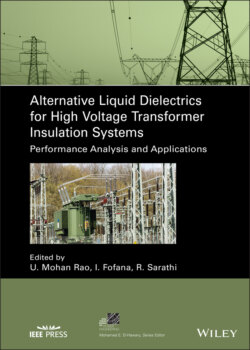Читать книгу Alternative Liquid Dielectrics for High Voltage Transformer Insulation Systems - Группа авторов - Страница 17
1.2 Insulation System in Liquid‐Filled Transformers
ОглавлениеLiquid insulation in transformers plays a critical role in assessing the lifetime of a transformer. Useful life of a transformer relies on the electrical health and effectiveness of insulating oil. Owing to prevalent thermal conditions within an in‐service oil‐filled transformer, the performance of solid insulation paper, pressboard, etc., and the effectiveness of the insulating oil to serve as an insulator and as a coolant, reduces significantly over a period. High thermal excursions in the transformer tend to accelerate the aging process of the oil–paper insulation. Eventually, insulation paper degrades by releasing certain gases, moisture, furan‐based compounds, and suspended particles percolating into the insulation oil; thus, enhances the deterioration of oil. As per ASTM D117‐18 [20] standard, commonly adapted parameters of insulation oil to monitor the transformers are classified as electrical, physical, and chemical.
Hence, degradation of insulation paper can be estimated by performing diagnostic and prognostic tests on the insulation oil. Simply, characterization of insulation oil facilitates prediction of performance aspects of insulation and helps estimate the prevailing conditions within the in‐service oil‐filled transformers. It has been a past practice of the power industry to perform diagnosis tests on the insulation oil in view of condition monitoring of an oil‐filled transformer. Insulation system being the heart of the transformer comprises the liquid insulation (typically oils) and solid insulation system (typically cellulose). Traditionally, mineral insulating oils are put up in practice for the transformer insulation technology. Due to the fact that mineral oils are expected to reach depletion, alternative candidates for these oils is a challenge. Further, mineral oils are toxic and nonbiodegradable. Thus, demanding an alternative candidate, which is biodegradable and nontoxic while meeting the technical requirements that an insulating liquid should exhibit. It is desired that a transformer insulating liquid has good dielectric strength, high thermal performance (high fire point), and has good compatibility with the transformer solid insulation. Classification of several insulation parameters that are used by the industry to monitor the performance of transformer insulation is shown in Figure 1.1.
Parameters highlighted in Figure 1.1 are fundamental parameters that majority of the utilities monitor to access the aging level of insulation in the transformers. All the abovementioned parameters of in‐service insulation oil are classified based on the nature of liquid insulating medium (property) in oil‐filled transformers. However, the aging aspects of transformers are highly interrelated and measuring oil–paper insulation aging has become an established interdisciplinary engineering application field of materials science and chemical engineering through latest instrumentation and aging measurements by various techniques and processes.
Figure 1.1 Basic insulation parameters for aging assessment of oil–paper insulation.
